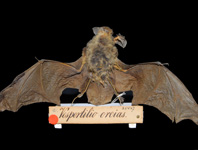Abstract
New amphibian species have been constantly discovered throughout southern China, including from areas close to heavily populated cities that remain poorly surveyed for amphibian diversity. We describe a new species of the newt genus Paramesotriton from Fujian, a developed province on the southeastern coast of mainland China. The mitochondrial genealogy suggests that the new species is the sister taxon to Paramesotriton hongkongensis, separated by an uncorrected pairwise distances of 5.8% at the ND2 gene fragment analyzed. In addition to the genetic divergence, the new species can be readily differentiated from its congeners by having: a very rough skin; a continuous, orange, vertebral ridge; few warts on each side of the vertebral ridge; numerous small irregular orange-red or yellow spots on the chin, venter, underside of axillae, flanks, lateral side of the tail, base of limbs and cloaca; a small groove at the base of the vomerine tooth series; relatively long tail, relatively flat cloaca in females; normally developed eyes, and the absence of vestigial gills and gill filaments in adults.
References
Darriba, D., Taboada, G.L., Doallo, R. & Posada, D. (2012) JModelTest 2: more models, new heuristics and parallel computing. Nature Methods, 9, 772–772.
Edgar, R.C. (2004) MUSCLE: multiple sequence alignment with high accuracy and high throughput. Nucleic Acids Research, 32, 1792–1797.
Fei, L., Hu, S., Ye, C. & Huang, Y. (2006) Fauna Sinica, Amphibia Anura, Vol. 1. Beijing, China: Science Press. [In Chinese]
Fei, L., Ye, C. & Jiang, J. (2012) Colored atlas of Chinese amphibians and their distributions. Sichuan Publishing House of Science and Technology, Chengdu, 619 pp. [In Chinese]
Gu, X., Chen, R., Tian, Y., Li, S. & Ran, J. (2012a) A new species of Paramesotriton (Caudata: Salamandridae) from Guizhou Province, China. Zootaxa, 3510, 41–52.
Gu, X., Wang, H., Chen, R., Tian, Y. & Li, S. (2012b) The phylogenetic relationships of Paramesotriton (Caudata: Salamandridae) based on partial mitochondrial DNA gene sequences. Zootaxa, 3150, 59–68.
Hou, M., Wu, Y., Yang, K., Zheng, S., Yuan, Z. & Li, P. (2014) A missing geographic link in the distribution of the genus Echinotriton (Caudata: Salamandridae) with description of a new species from southern China. Zootaxa, 3895 (1), 89–102.
http://dx.doi.org/10.11646/zootaxa.3895.1.5Lu, S., Yuan, Z., Pang, J., Yang, D., Yu, F., McGuire, P., Xie, F. & Zhang, Y. (2004) Molecular phylogeny of the genus Paramesotriton (Caudata: Salamandridae). Biochemical Genetics, 42, 139–148.
Li, S., Tian, Y. & Gu, X. (2008a) A new species of the genus Paramesotriton (Caudata, Salamandridae). Acta Zootaxonomica Sinica, 33, 410–413. [In Chinese]
Li, S., Tian, Y., Gu, X. & Xiong, R. (2008b) A new species of Paramesotriton—Paramesotriton longliensis (Caudata: Salamandridae). Zoological Research, 29, 313–317. [In Chinese]
Rambaut, A. & Drummond, A. (2007) Tracer v1.5. Available at: http://beast.bio.ed.ac.uk/Tracer (Accessed 6 Dec. 2016)
Ronquist, F. & Huelsenbeck, J.P. (2003) MRBAYES 3: Bayesian phylogenetic inference under mixed models. Bioinformatics, 19, 1572–1574.
Sambrook, J., Fritsch, E. & Maniatis, T. (1989) Molecular cloning: a laboratory manual. 2nd Edition. Vol. 1–3. Cold Spring Harbor Laboratory Press, New York, 1626 pp.
Stamatakis, A., Hoover, P. & Rougemont, J. (2008) A rapid bootstrap algorithm for the RAxML web servers. Systematic Biology, 57, 758–771.
Tamura, K., Peterson, D., Peterson, N., Stecher, G., Nei, M. & Kumar, S. (2011) MEGA5: Molecular evolutionary genetics analysis using maximum likelihood, distance, and maximum parsimony methods. Molecular Biology and Evolution, 28, 2731–2739.
Weisrock, D.W., Papenfuss, T.J., Macey, J.R., Litvinchuk, S.N., Polymeni, R., Ugurtas, I.H., Zhao, E., Jowkar, H. & Larson, A. (2006) A molecular assessment of phylogenetic relationships and lineage accumulation rates within the family Salamandridae (Amphibia, Caudata). Molecular Phylogenetics and Evolution, 41, 368–383.
Wu, Y., Rovito S.M., Papenfuss, T.J. & Hanken, J. (2009) A new species of the genus Paramesotriton (Caudata: Salamandridae) from Guangxi Zhuang Autonomous Region, southern China. Zootaxa, 2060, 59–68.
Wu, Y., Jiang, K. & Hanken, J. (2010) A new species of newt of the genus Paramesotriton (Salamandridae) from southwestern Guangdong, China, with a new northern record of P. longliensis from western Hubei. Zootaxa, 2494, 45–58.
Yuan, Z., Zhao, H., Jiang, K., Hou, M., He, L., Murphy, R.W. & Che, J. (2014) Phylogenetic relationships of the genus Paramesotriton (Caudata: Salamandridae) with the description of a new species from Qixiling nature reserve, Jiangxi, southeastern China and a key to the species. Asian Herpetological Research, 5, 67–79.
Zhao, H., Che, J., Zhou, W., Chen, Y., Zhao, H. & Zhang, Y. (2008) A new species of Paramesotriton (Caudata: Salamandridae) from Guizhou Province, China. Zootaxa, 1775, 51–60.

